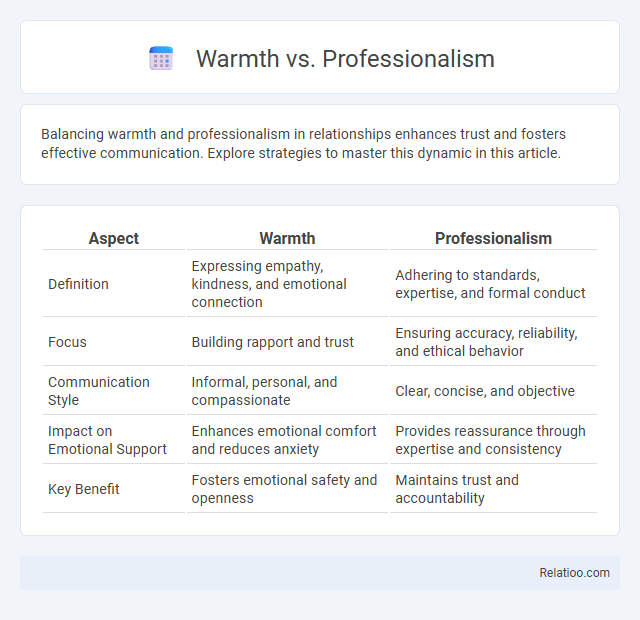Balancing warmth and professionalism in relationships enhances trust and fosters effective communication. Explore strategies to master this dynamic in this article.
Table of Comparison
| Aspect | Warmth | Professionalism |
|---|---|---|
| Definition | Expressing empathy, kindness, and emotional connection | Adhering to standards, expertise, and formal conduct |
| Focus | Building rapport and trust | Ensuring accuracy, reliability, and ethical behavior |
| Communication Style | Informal, personal, and compassionate | Clear, concise, and objective |
| Impact on Emotional Support | Enhances emotional comfort and reduces anxiety | Provides reassurance through expertise and consistency |
| Key Benefit | Fosters emotional safety and openness | Maintains trust and accountability |
Understanding Warmth and Professionalism
Understanding warmth and professionalism involves balancing empathy with competence to foster effective workplace relationships. Warmth, characterized by approachability and genuine care, enhances trust and collaboration, while professionalism emphasizes reliability, expertise, and adherence to standards. Integrating both qualities promotes a positive organizational culture where individuals feel valued and confident in their roles.
The Psychology Behind Warmth in Communication
The psychology behind warmth in communication centers on creating emotional connections that foster trust and openness, essential for effective interpersonal interactions. Warmth signals empathy and understanding, which reduces psychological barriers and enhances cooperation in professional settings. Your ability to balance warmth with professionalism influences how others perceive your credibility and approachability, impacting both personal and organizational relationships.
Defining Professionalism in the Modern Workplace
Defining professionalism in the modern workplace involves balancing warmth and competence to foster trust and effective communication. Emphasizing warmth enhances interpersonal connections and team collaboration while maintaining clear boundaries ensures respect and productivity. Modern professionalism integrates emotional intelligence with expertise to create inclusive, efficient, and positive work environments.
Warmth vs Professionalism: Key Differences
Warmth emphasizes empathy, approachability, and emotional connection, fostering trust and collaboration in personal and professional relationships. Professionalism prioritizes competence, reliability, and adherence to standards, ensuring credibility and efficiency in the workplace. Balancing warmth and professionalism enhances communication, creating an environment that values both human connection and effective performance.
Situational Importance: When to Prioritize Warmth
Warmth becomes essential in contexts requiring trust and empathy, such as healthcare or counseling, where connecting emotionally with others supports positive outcomes. You should prioritize warmth when building relationships or resolving conflicts, as it fosters openness and collaboration. In contrast, professionalism takes precedence during formal negotiations or performance evaluations, where clarity and authority are critical.
When Professionalism Matters Most
Professionalism matters most in high-stakes environments where accuracy, reliability, and clear communication directly impact outcomes, such as legal settings, healthcare, and corporate negotiations. Your ability to maintain professionalism demonstrates competence, builds trust, and ensures that interactions remain respectful and goal-oriented. Balancing warmth with professionalism enhances rapport without compromising authority or credibility.
The Impact of Warmth on Client Relationships
Warmth significantly enhances client relationships by fostering trust, comfort, and open communication, which leads to higher client satisfaction and loyalty. Your ability to convey genuine warmth while maintaining professionalism can differentiate your service, making clients feel valued and understood. Balancing warmth with professionalism ensures positive interactions without compromising credibility or authority.
Maintaining Professionalism Without Losing Humanity
Maintaining professionalism without losing warmth requires balancing clear communication with genuine empathy, ensuring your interactions remain respectful yet personable. Your ability to convey understanding and kindness fosters trust and collaboration while upholding organizational standards and expectations. This approach enhances workplace relationships, promoting a positive environment where professionalism and humanity coexist effectively.
Striking the Ideal Balance: Tips and Strategies
Striking the ideal balance between warmth and professionalism involves maintaining clear communication while expressing genuine empathy to build trust and rapport. Incorporate active listening and personalized responses to foster connection without compromising authority or clarity. Utilize approachable language paired with confident body language to create an environment that is both welcoming and respectful.
The Future of Workplace Culture: Warmth and Professionalism Combined
The future of workplace culture emphasizes a balanced integration of warmth and professionalism, fostering environments where empathy enhances productivity and employee engagement thrives. Organizations adopting this blend demonstrate increased collaboration, innovation, and retention rates by nurturing genuine human connections without compromising efficiency. Embracing warmth alongside professionalism cultivates trust and respect, positioning companies for sustained success in evolving global markets.

Infographic: Warmth vs Professionalism
 relatioo.com
relatioo.com